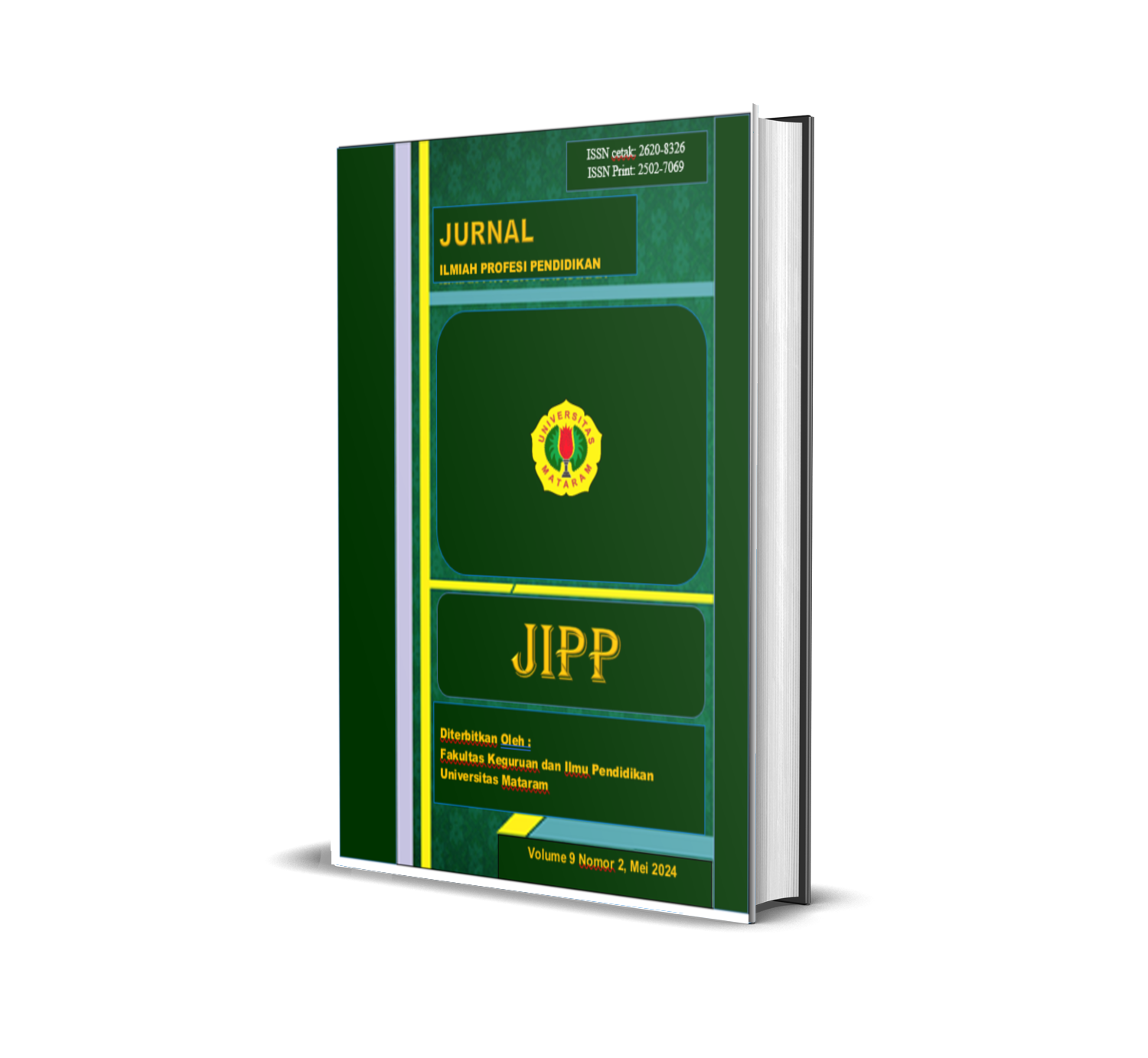An Analysis of Factors Causing Students’ Reticence in Speaking Classes
Penulis
Ni Putu Sita Artarini , Muhammad Amin , Yuni Budi Lestari , Ahmad JunaidiDOI:
10.29303/jipp.v9i3.2507Diterbitkan:
2024-08-21Terbitan:
Vol 9 No 3 (2024): AgustusKata Kunci:
Anxiety, Confidence, Proficiency, Reticence.Articles
##submission.downloads##
Cara Mengutip
Abstrak
This research describes factors causing many students in an EFL classroom struggle with speaking due to reticence, which significantly impacts their language learning and academic achievement. This study aims to identify and describe the factors causing students' reticence and propose possible strategies to cope with students' reticence in speaking classes in the English Education Department. It applied a descriptive qualitative approach, chosen specifically to offer a straightforward description of the phenomenon of the research. Data collection for this study was carried out using observation and interviews. This study involved 13 students as the sample of reticence students. The results revealed nine (9) key factors causing students' reticence in speaking classes. These include anxiety, personality (introverted), lack of confidence, lack of motivation, and low English proficiency. Additionally, fear of negative evaluation, unwillingness to participate, comparison with peers, and uncomfortable classroom atmosphere were identified as significant contributors to students' reluctance to engage in speaking activities. The findings also comprise the strategies to cope with students’ reticence in speaking classes involved classroom arrangements which refers to students’ seating position that makes students participate more and enjoy the class with their peers and using an appropriate teaching method.
Referensi
Aripin, J., & Umam, A. (2019). Dealing with Students’ Reticence in Speaking Activity in Efl Classroom. English Journal, 13(1), 1–8. https://doi.org/10.32832/english.v13i1.3774
Augustin, M. (2017). An Analysis of Students’reticence in Speaking Class (Doctoral dissertation, Unika Soegijapranata Semarang). http://repository.unika.ac.id/id/eprint/16350
Cheng, X. (2000). Asian students' reticence revisited. System, 28(4), 435-446.
Cieniewicz, J. (2007). Participation blues from the student perspective. In M. Weimer (Ed.), Tips for encouraging student participation in classroom discussions (p. 5). Wisconsin: Magna Publications.
Creswell, J. W. (2007). Qualitative inquiry & research design: Choosing among five approaches (2nd). California: Sage. Honthaner.
Doqaruni, V. R. (2015). Increasing confidence to decrease reticence: A qualitative action research in second language education. Canadian Journal of Action Research, 16(2), 42-60. https://doi.org/10.33524/cjar.v16i3.227
Hariyudin, A., & Jamilah, A. S. (2018). Teachers' difficulties in teaching speaking using audio visual aid for autistic students. Eltin: Journal of English Language Teaching in Indonesia, 6(2), 107-116. https://doi.org/10.22460/eltin.v6i2.p107-116
Irwanti, E. (2017). The Reasons of Students' Reticence In English Education Study Program. Jurnal Pendidikan dan Pembelajaran Khatulistiwa, 6(5). https://dx.doi.org/10.26418/jppk.v6i5.20138
Kelly, L., & Keaten, J. A. (2000). Treating communication anxiety: Implications of the communi biological paradigm. Communication Education, 49(1), 45-57. http://dx.doi.org/10.1080/03634520009379192
Li, H., & Liu, Y. (2011). A brief study of reticence in ESL class. Theory and Practice in Language Studies, 1(8), 961-965. http://dx.doi.org/10.4304/tpls.1.8.961-965
Littlewood, W. (1981). Communicative Language Teaching. Cambridge, UK: Cambridge University Press.
Liu, M. (2007). Anxiety in oral English classrooms: A case study in China. Indonesian Journal of English Language Teaching, 3(1), 119-137. https://dx.doi.org/10.25170/ijelt.v3i1.132
Liu, M., & Jackson, J. (2008). An exploration of Chinese EFL learners’ unwillingness to communicate and foreign language anxiety. The Modern Language Journal, 92(1), 71-86. http://dx.doi.org/10.1111/j.1540-4781.2008.00687.x
Liu, M., & Jackson, J. (2009). Reticence in Chinese EFL students at varied proficiency levels. TESL Canada Journal, 26(2), 65-81. https://doi.org/10.18806/tesl.v26i2.415
Luoma, S. (2004). Assessing speaking. Cambridge university press.
Miles, M.B, Huberman, A.M, & Saldana, J. (2014). Qualitative Data Analysis, A. Methods Sourcebook, Edition 3. USA: Sage Publications. https://books.google.com/books/about/Qualitative_Data_Analysis.html?id=p0wXBAAAQBAJ
Nunan, D. (1999). Second Language Teaching & Learning. USA. Heinle & Heinle Publisher.
Nuqul, F. L. (2006). Perbedaan intensitas kepatuhan terhadap aturan ditinjau dari tipe kepribadian introvert-ekstrovert, jenis kelamin dan tahun angkatan. Laporan Penelitian.
Ohata, K. (2005). Potential sources of anxiety for Japanese learners of English: Preliminary case interviews with five Japanese college students in the U.S. Teaching English as a Second or Foreign Language, 9(3), 1-21. https://eric.ed.gov/?id=EJ1065859
Phillips, J. B. (1996). New Testament in Modern English. Simon and Schuster.
Price, M. L. (1991). The subjective experience of foreign language anxiety: Interviews with highly anxious students. In E. K. Horwitz & D. J. Young (Eds.), Language anxiety: From theory and research to classroom implications* (pp. 101-108). Englewood Cliffs, NJ: Prentice Hall.
Putra, R. D. (2020). Speaking barriers in learners of English as a foreign language at the fourth semester in Sekolah Tinggi Keguruan dan Ilmu Pendidikan Muhammadiyah Kotabumi academic year 2018/2019. Retrieved from [Repository Universitas Muhammadiyah Kotabumi] https://repository.umko.ac.id/id/eprint/36/
Qoriah, D., & Farisya, G. (2022). Communicative language teaching (CLT) method combined with total physical response (TPR) method on upgrading communication skill on English laboratory. Journal Civic and Social Studies, 6(2), 120-129. https://doi.org/10.31980/civicos.v6i2.2319
Riasati, M. J. (2014). Causes of reticence: Engendering willingness to speak in language classroom. International Journal of Research Studies in Language Learning, 3(1), 115-122. https://www.researchgate.net/publication/284348043_Causes_of_reticence_Engendering_willingness_to_speak_in_language_classrooms
Richards, J. C., & Rodgers, T. S. (2001). Approaches and Methods in Language Teaching (2nd ed.). New York, NY: Cambridge University Press. https://www.novaconcursos.com.br/blog/pdf/richards-jack-c.-&-rodgers.pdf
Sugiyono (2018). Metode Penelitian Kuantitatif, Kualitatif, dan R&D. Bandung: Alfabeta.
Sugiyono (2019). Metode Penelitian Kuantitatif, Kualitatif, dan R&D. Bandung: Alphabeta.
Ulya, N., & Ichsan (2021). Pengaruh metode total physical response pada perkembangan kosakata bahasa Inggris anak usia dini. Jurnal Inovasi Pendidikan Guru Raudhatul Athfal, 9(2), 235-249. http://dx.doi.org/10.21043/thufula.v9i2.11002
Van Den Branden, K., Bygate, M., & Norris, J. M. (Eds.) (2009). TaskBased Language Teaching: A Reader. Amsterdam: John Benjamin Publishing. https://doi.org/10.1075/tblt.1
Wulandari, R. A., Supardi, I., & Rosnija, E. (2015). A Study of Students' Reticence Causes In English Class of Vocational High School. 4(1). https://dx.doi.org/10.26418/jppk.v4i1.8612
Zeng, M. (2010). Chinese students’ willingness to communicate in English in Canada. Unpublished doctoral dissertation, Ontario, Canada. https://scholar.uwindsor.ca/etd/7966/
Zua, L. (2008). Exploring the Affective Factors Influencing Teaching of Spoken English.
Lisensi
Hak Cipta (c) 2024 Ni Putu Sita Artarini, Muhammad Amin, Yuni Budi Lestari, Ahmad Junaidi

Artikel ini berlisensi Creative Commons Attribution 4.0 International License.

 klik di sini
klik di sini 
























